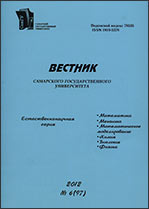|
Mathematical Methods in Natural Sciences
Scenarios model of the effect of a temporary sharp reduction of population with a large reproductive parameter
A. Yu. Perevaryukha
Laboratory of Applied Computer Science, St. Petersburg Institute
for Informatics and Automation of the Russian,
Academy of Sciences, Saint Petersburg, Russian Federation
(published under the terms of the Creative Commons Attribution 4.0 International License)
Abstract:
Our ongoing research is devoted to various aspects of predicting invasive processes in unstable biosystems. Extreme events are interesting for modeling. The purpose of this work is to describe in a computational experiment a scenario of active counteraction, which temporarily suppresses the development of an aggressive invasive process. The impact in a situation of slow regulation begins to affect not the small initial group $N(0)\approx L$ of individuals of the invading species, but only when the critical population threshold is reached. Relevance — let us consider in the model a scenario that can be interpreted as an artificially created resistance in case of delayed immune activation. In most cases, after invasion, the presence of the species remains, but below its biological optimum. Method — a modification of the equation with two delays is used. Novelty — a model has been obtained where it is possible to overcome the crisis or the death of the population, depending on the time of activation of the impact. The oscillatory scenario is not observed in the model. The equation with a threshold reaction assumes further expansion and use in the composition of multicomponent polymodel complexes.
Keywords:
models of population dynamics, invasion, insect outbreaks, growth models, stages of ontogenesis, hybrid systems, Allee effect, bifurcations and cycles, cognitive graphs, extinction of biological species.
Received: 15.03.2021
Revised: 19.04.2021
Accepted: 28.05.2021
Citation:
A. Yu. Perevaryukha, “Scenarios model of the effect of a temporary sharp reduction of population with a large reproductive parameter”, Vestnik SamU. Estestvenno-Nauchnaya Ser., 27:2 (2021), 80–90
Linking options:
https://www.mathnet.ru/eng/vsgu658 https://www.mathnet.ru/eng/vsgu/v27/i2/p80
|

|




 Contact us:
Contact us: Terms of Use
Terms of Use
 Registration to the website
Registration to the website Logotypes
Logotypes








 Citation in format
Citation in format 